Now you are outside of a residence. Here is a typical door with a few additional items. Advertisements but also notices are posted on doors. If you don’t understand a message placed on your door, bring it to work and ask a co-worker as it could be anything from a failed delivery to needing to check your gas line. For this page, let’s look at the door bell first as there aren’t many variations for these.
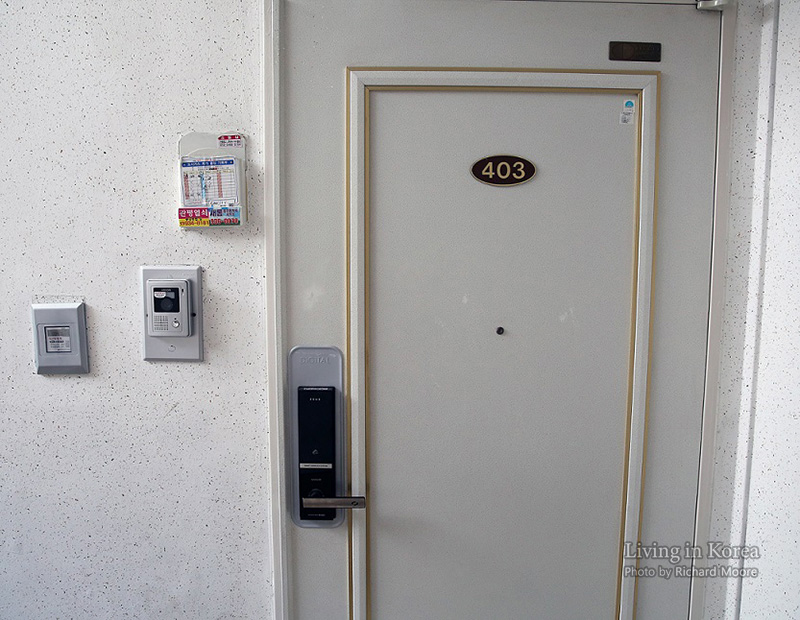
Most residences have a doorbell with imbedded camera and microphone. This adds a layer of security for the resident as it gives them a chance to see and hear who is outside of their door. Once the doorbell button is pushed, the camera and mic are turned on. You’ll notice some tape residue on the bottom as food delivery people frequently tape advertisements to here or the door.
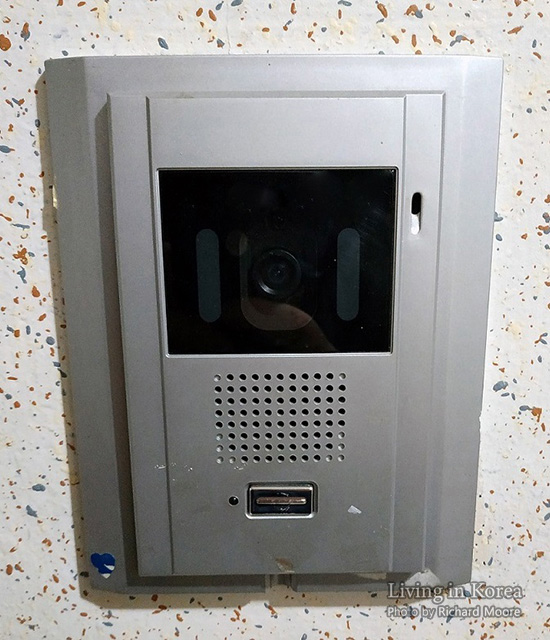
Very common in Korea are digital locks sometimes combined with the door handle and sometimes as a unit separate from the door knob. The term is 도어록 which is a phonetic loanword of door lock. They usually come with several keycards the size of a business card, a smaller card that can be attached to your phone via a tassel, and/or a small square which can be put inside your smartphone case.
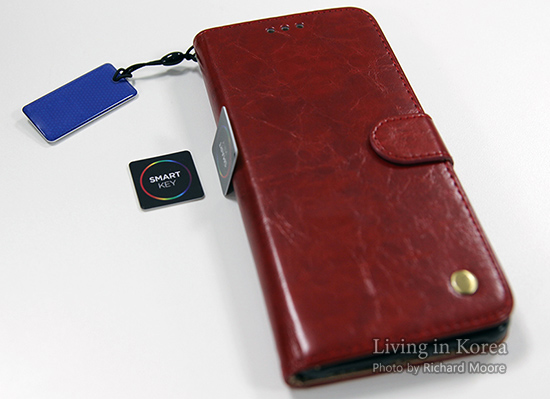
Keycards aren't necessary as a code can also be typed to gain entry. The images below show the unit in a waiting state (left) and once it is touched buttons appear (right). Passwords are typically four digits long and end with * or #. Locksmiths frequently leave their phone number on a sticker and place it on top of the unit – which can partially be seen in the image below.
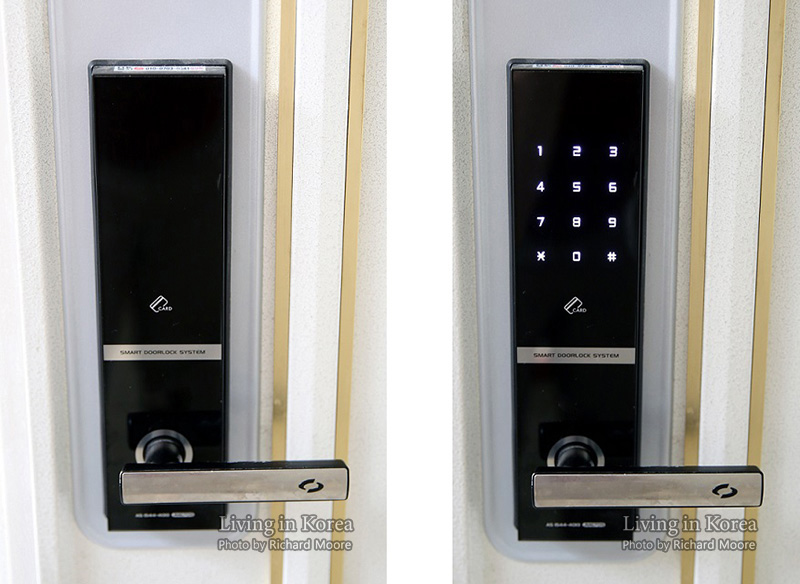
The other style of digital locks is a sliding version. The left image is in a waiting state and the right image is when the unit is slid open. The keys are illuminated for a few seconds to help if your hallway is dark and then go into a power saving mode if you don’t input a password. Codes are also typically four digits long and end either by pressing * or # or end when you slide the unit closed.
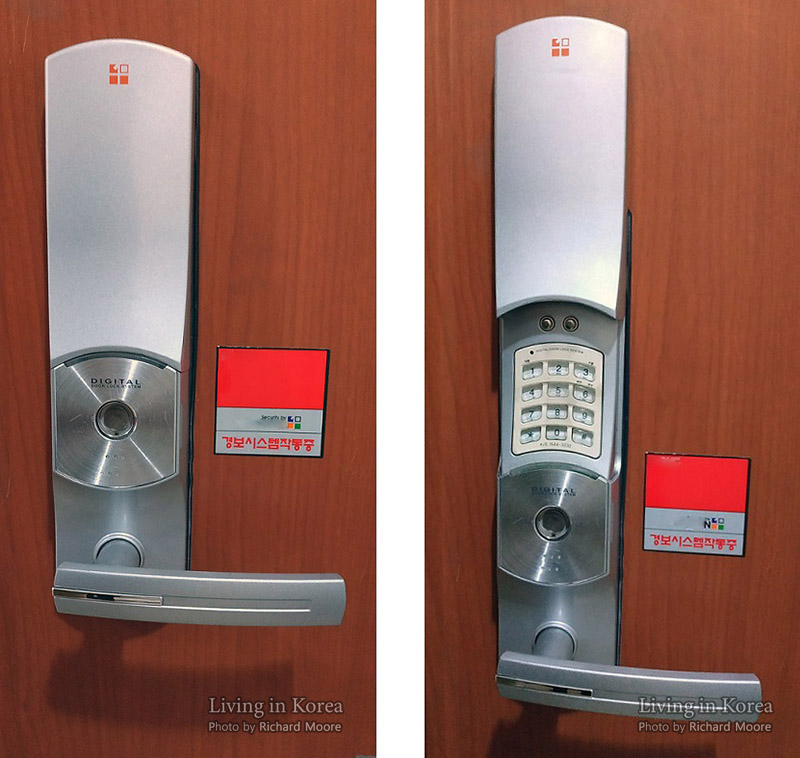
Both types allow for the owner to change the password and specialized instructions are included. If you need help, bring the directions to home and ask someone to help you understand the information. Be careful when you change the code as it is easy to lock yourself out if you mess up. Prop the door open, change the code, and confirm by letting the door think it is closed, and then confirm it works. As these are digital locks, they can’t be physically “picked” like a standard lock can. If all keycards are lost and the code is unknown, if the touchscreen or buttons malfunction, or if the batteries completely die, you cannot gain entry. You’ll need to call a locksmith who will drill a large hole into the unit to then manually disengage the lock. Then a new unit needs to be purchased and installed. If this is your mistake, be prepared to pay the locksmith person for their time and for a new lock; uour landlord will not cover this cost.
However, in the last example where your batteries are completely drained, many of these door locks have a way to manually provide additional power via a 9V battery to the bottom of the device. First look at the bottom of the device and see if there are two rectangular boxes; they could be silver or black in color. If you see these on the lock, you’ll need to purchase a 9V battery along with enough AA batteries to switch out the dead AA batteries; usually four. Take the 9V battery and touch it to the two rectangles you saw. This bypasses the dead batteries and provides enough power to enter your code and unlock the door. Once inside, immediately change the dead AA batteries. The image below shows the two rectangles on the bottom of the door lock. The image was taken after the unit’s touch screen malfunctioned and needed to be replaced, which is why the image is held in a hand and not installed on a door.
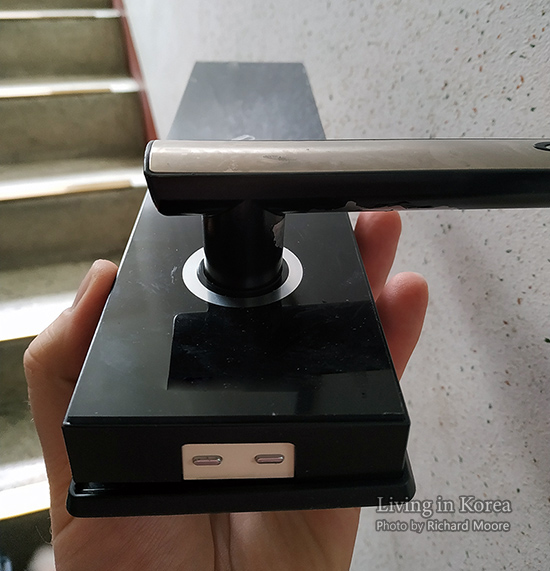
Alternatively the 9V battery connection point might be located on the front faceplate of the door lock. Here is one with the slider in the open position and we can see the two rectangles at the top of the faceplate.
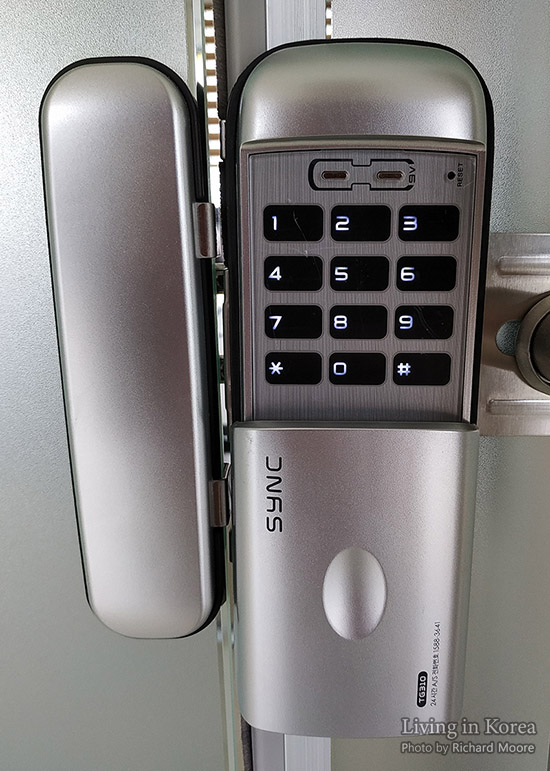
If people are getting something large delivered while they are out of the home, for example a sofa or a refrigerator, they will change the code to something simple like 0000, tell that code to the delivery person, and then change the code again once they get home.
These digital door locks are also used for restaurant bathrooms if the bathrooms is in a public area, for example a stairwell. This ensures that only patrons for that particular restaurant can use it and not those who just pop into the stairwell of a business building hoping to find a restroom. This sign next to the exit door says the restroom (화장실, 化粧室, hwajangsil) password is 0000* but these signs are frequently shortened to simply 화장실 and the numeric password.
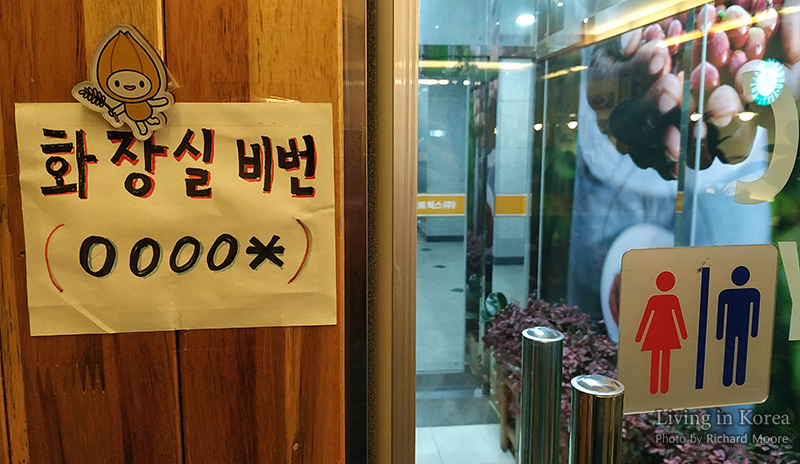
Upon successfully closing and locking the door, you'll hear a confirmation beep. When the batteries get low the locking mechanism make a number of loud beeps to warn you. This audible code will be different from the loud beeps if the door is partially closed but the lock is unable to engage until the door is fully closed.
Analog door locks exist as well. If yours is not digital, you’ll be given physical keys. Instead of keys with teeth that hang down, these keys have circles drilled to varying depths on three sides of a cylinder which makes the locking mechanism harder to pick. They are slightly more expensive to make copies of but any locksmith or even any other store that can make keys (e.g. some hardware stores and some shoeshine shops), can make these cylinder keys as well. If you make a copy of these keys, make sure they are made correctly as the cylinder can only be inserted one way. This means that if the new key was made upside down, you will be unable to fit it into the lock.
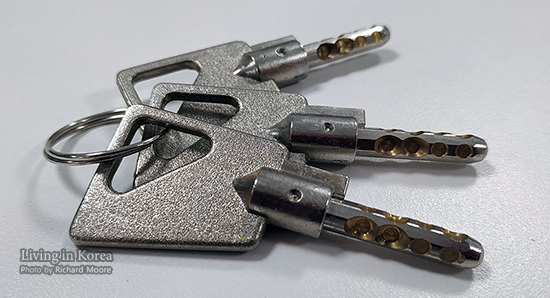
The Korean term for key, locksmith, and keycard are all interchangeable; 열쇠 (yeolsoe). The circular red sign shown in the image below is advertising a locksmith. The word 열쇠 is also one of the only, if not the only word written on advertisement stickers that they place on your door handle on locking mechanism.

Some other stores, such as shoeshine or shoe repair stores and some hardware stores will also have the ability to make keys. If you do not see the word 열쇠, look for a key cutting machine; two examples are shown here.
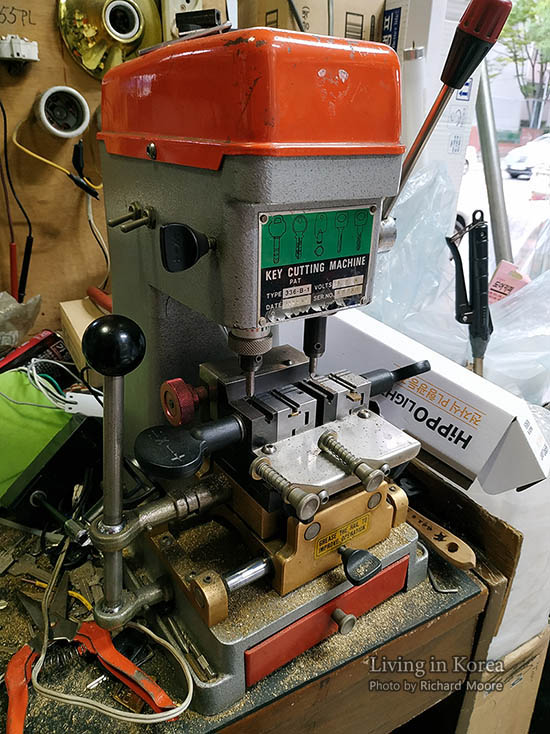
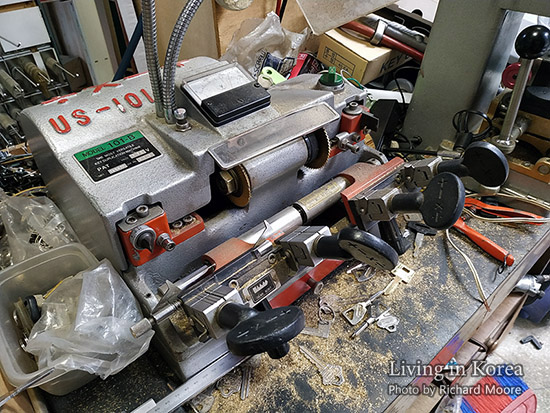
As the shoe-based stores are quite small, they may not have the physical space to store new locks. By comparison, hardware stores are much bigger and if they make keys, they’ll probably sell a few locks as well and can offer to install them for you. The price they tell you should include the door lock and installation fee. Typically, if you are buying a new lock for your home, they’ll come over immediately to install it. If they have other customers, or if a meal time is about to start, they’ll come by your home right after. This means you’ll need to tell them where you live and the easiest way is to pull out your Residence Card, flip it over and show them your address on the reverse side.
The front door is also where you’ll find notes from people who came by when you weren’t home. Here is a note from the gas company who tried to do a safety check of the home, specifically the kitchen as that is where the bendable gas hose connects to the metal pipe that provides the gas supply.

In this note, the post office tried to drop off something that requires a signature or your permission to drop it off without a signature. The red box at the bottom provides you with the delivery person’s name and work smartphone number so they can be contacted if need be. For privacy reasons we can removed the contact information. Note they addressed it to 앤드류 (Andrew) despite the receiver being named Richard Andrew Moore. This is because of the name order on your Residence Card being GIVEN MIDDLE FAMILY, i.e. Moore Richard Andrew, that they think the preferred name is Andrew and not Richard. If you want a closer look at the memo, click the image to see a larger size.
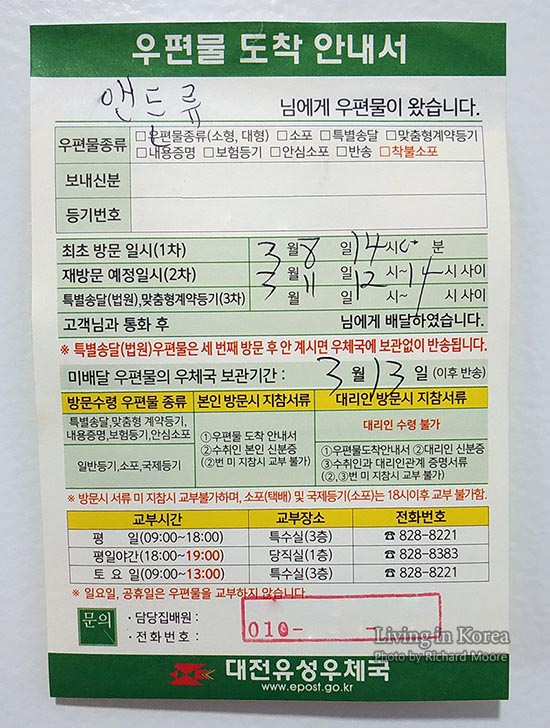
Sometimes located near the door is a gauge showing your electricity consumption but this could be located elsewhere. Here are two designs that we've found.
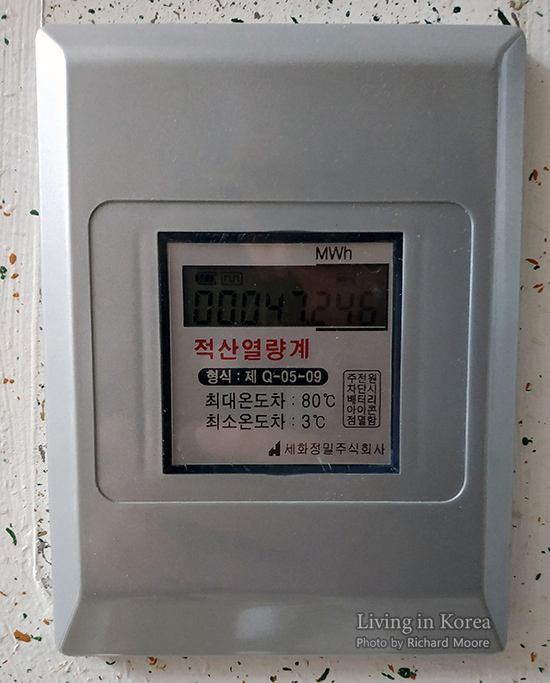
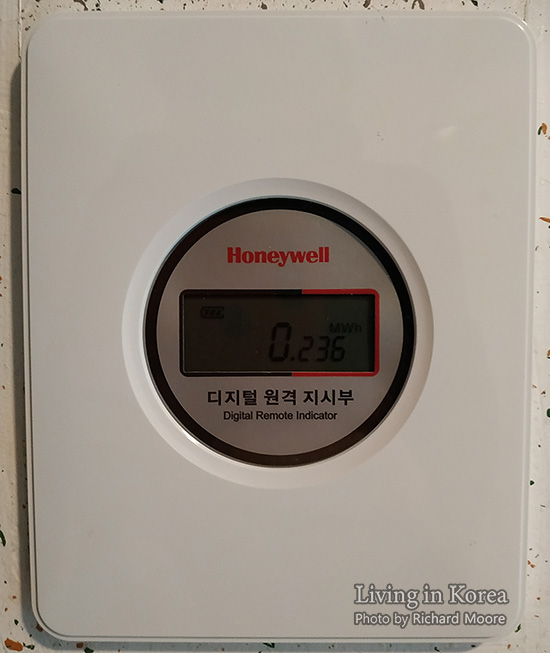
If your gas meter is located within your veranda, the gas company cannot easy check your gas usage and adequately bill you for the gas that you used. When this is the case they will ask all residents to check the meter and record the usage on a tab located next to your frot door. Here is where you will write down the gas usage if your meter is located within your home. The top of this is unfortunately covered with advertisements for locksmiths or other services, so the title cannot properly be seen.
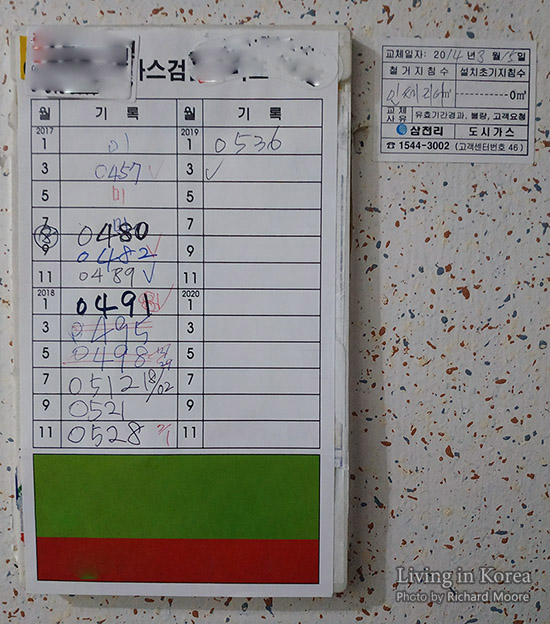
Here is a notice telling residence that someone will come and record the gas usage on the 9th (9일) and asks everyone to check their meters and write the usage information on the chart by their front door by the 8th (8일까지기록!). These notices are usually placed in more public areas, like near the mailboxes or the entrance to the elevator. If you want a closer look, click the image to see a larger size.
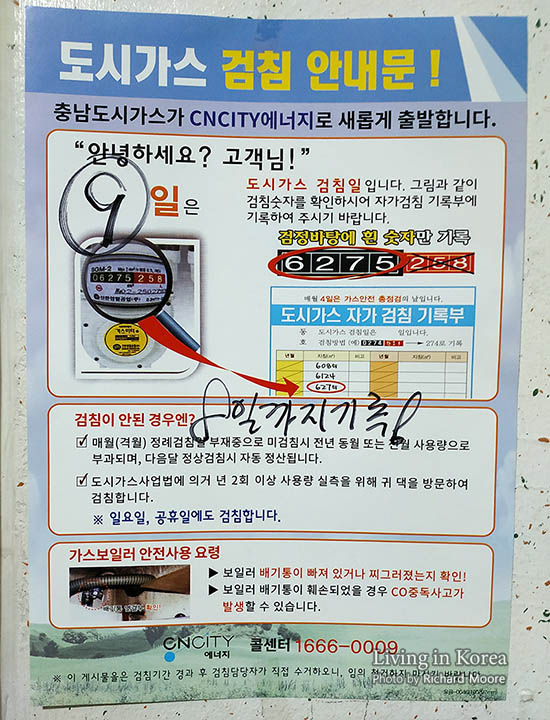
At the bottom of many doors is a small opening for newspapers or milk to be delivered inside of a home as to limit their theft. As these items are getting delivered less and less to homes, and as there are privacy concerns, these are sometimes sealed.
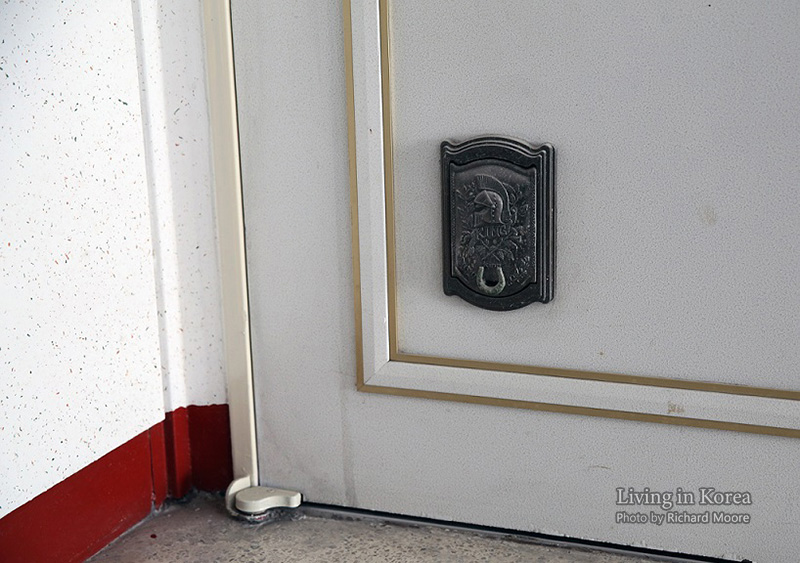
Another delivery method for milk was in these temperature coated bags that would hang either off a door knob or off the stairwell railing. Visit enough homes and you’ll see a few of them.

Many floors have a large fire hose in case of an emergency. As fires are rare, and delivery people are keep for finding safe places to hide packages until the intended reception arrives, they frequently place packages in these fire hose storage areas. Often a note is left on the door telling you to check that cabinet, which kind of defeats the purpose of hiding the package. If you get something delivered but cannot find it, open this door and take a look inside.
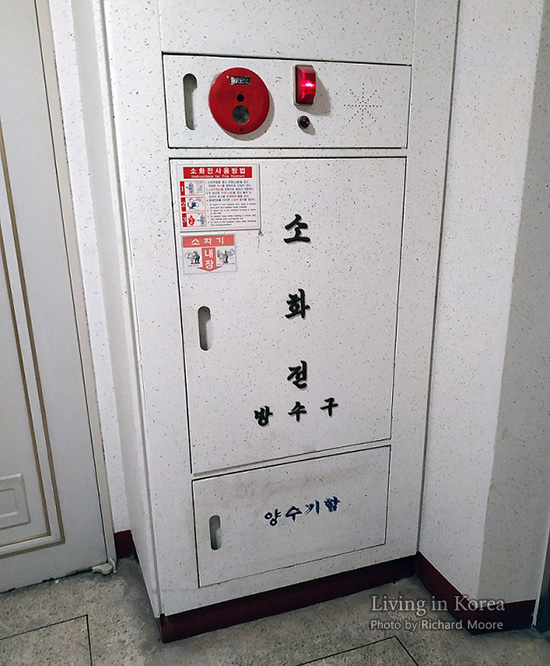
Having entered the home, let's take a look at the inside of the entrance way.